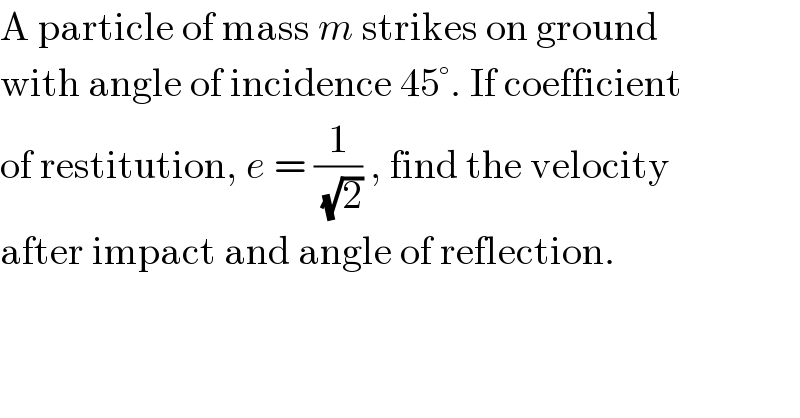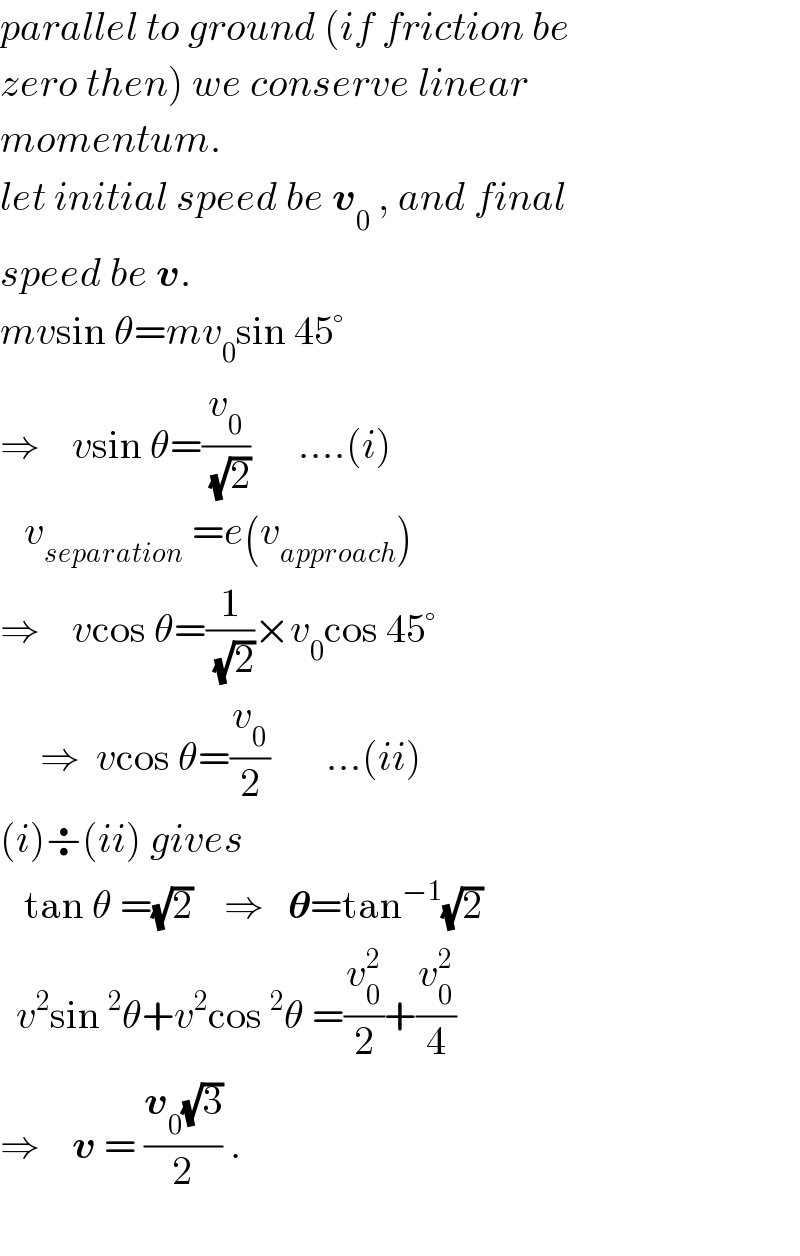
Question Number 23049 by Tinkutara last updated on 25/Oct/17

$$\mathrm{A}\:\mathrm{particle}\:\mathrm{of}\:\mathrm{mass}\:{m}\:\mathrm{strikes}\:\mathrm{on}\:\mathrm{ground} \\ $$$$\mathrm{with}\:\mathrm{angle}\:\mathrm{of}\:\mathrm{incidence}\:\mathrm{45}°.\:\mathrm{If}\:\mathrm{coefficient} \\ $$$$\mathrm{of}\:\mathrm{restitution},\:{e}\:=\:\frac{\mathrm{1}}{\sqrt{\mathrm{2}}}\:,\:\mathrm{find}\:\mathrm{the}\:\mathrm{velocity} \\ $$$$\mathrm{after}\:\mathrm{impact}\:\mathrm{and}\:\mathrm{angle}\:\mathrm{of}\:\mathrm{reflection}. \\ $$
Answered by ajfour last updated on 25/Oct/17

$${parallel}\:{to}\:{ground}\:\left({if}\:{friction}\:{be}\right. \\ $$$$\left.{zero}\:{then}\right)\:{we}\:{conserve}\:{linear} \\ $$$${momentum}. \\ $$$${let}\:{initial}\:{speed}\:{be}\:\boldsymbol{{v}}_{\mathrm{0}} \:,\:{and}\:{final} \\ $$$${speed}\:{be}\:\boldsymbol{{v}}. \\ $$$${mv}\mathrm{sin}\:\theta={mv}_{\mathrm{0}} \mathrm{sin}\:\mathrm{45}°\: \\ $$$$\Rightarrow\:\:\:\:{v}\mathrm{sin}\:\theta=\frac{{v}_{\mathrm{0}} }{\sqrt{\mathrm{2}}}\:\:\:\:\:\:....\left({i}\right) \\ $$$$\:\:\:{v}_{{separation}} \:={e}\left({v}_{{approach}} \right) \\ $$$$\Rightarrow\:\:\:\:{v}\mathrm{cos}\:\theta=\frac{\mathrm{1}}{\sqrt{\mathrm{2}}}×{v}_{\mathrm{0}} \mathrm{cos}\:\mathrm{45}° \\ $$$$\:\:\:\:\:\Rightarrow\:\:{v}\mathrm{cos}\:\theta=\frac{{v}_{\mathrm{0}} }{\mathrm{2}}\:\:\:\:\:\:\:...\left({ii}\right) \\ $$$$\left({i}\right)\boldsymbol{\div}\left({ii}\right)\:{gives} \\ $$$$\:\:\:\mathrm{tan}\:\theta\:=\sqrt{\mathrm{2}}\:\:\:\:\Rightarrow\:\:\:\boldsymbol{\theta}=\mathrm{tan}^{−\mathrm{1}} \sqrt{\mathrm{2}} \\ $$$$\:\:{v}^{\mathrm{2}} \mathrm{sin}\:^{\mathrm{2}} \theta+{v}^{\mathrm{2}} \mathrm{cos}\:^{\mathrm{2}} \theta\:=\frac{{v}_{\mathrm{0}} ^{\mathrm{2}} }{\mathrm{2}}+\frac{{v}_{\mathrm{0}} ^{\mathrm{2}} }{\mathrm{4}} \\ $$$$\Rightarrow\:\:\:\:\boldsymbol{{v}}\:=\:\frac{\boldsymbol{{v}}_{\mathrm{0}} \sqrt{\mathrm{3}}}{\mathrm{2}}\:. \\ $$$$ \\ $$
Commented by Tinkutara last updated on 25/Oct/17

$$\mathrm{Thank}\:\mathrm{you}\:\mathrm{very}\:\mathrm{much}\:\mathrm{Sir}! \\ $$
